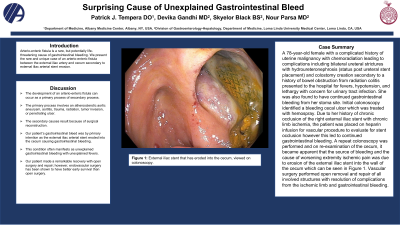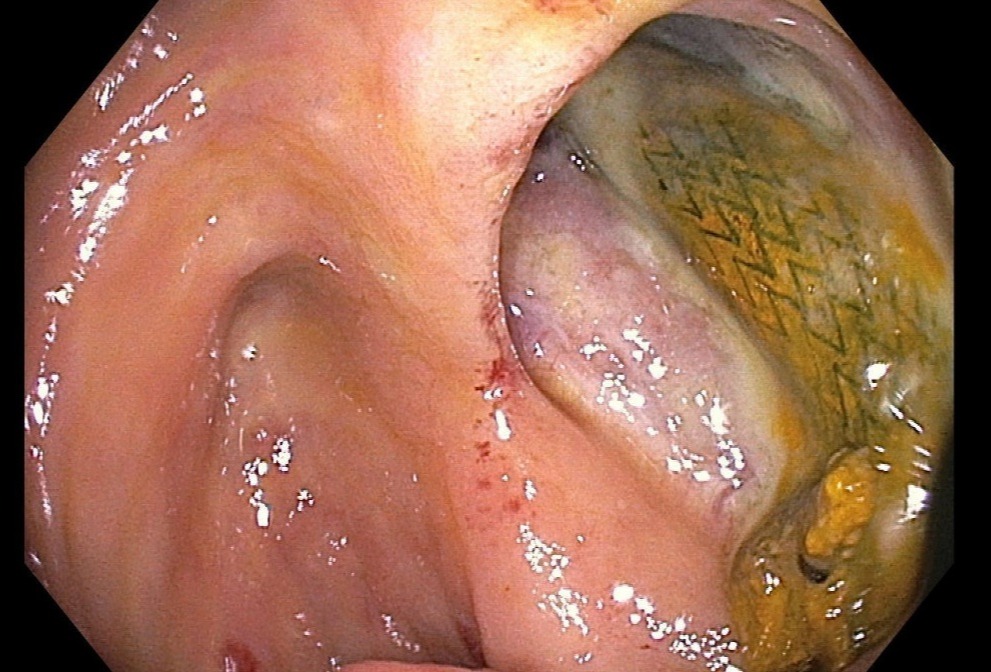Sunday Poster Session
Category: GI Bleeding
P0654 - Surprising Cause of Unexplained Gastrointestinal Bleeding: Erosion of External Iliac Stent into Cecum
Sunday, October 22, 2023
3:30 PM - 7:00 PM PT
Location: Exhibit Hall

Has Audio

Patrick Tempera, DO
Albany Medical Center
Albany, NY
Presenting Author(s)
Patrick Tempera, DO1, Devika Gandhi, MD2, Skyelor Black, BS3, Nour Parsa, MD3
1Albany Medical Center, Albany, NY; 2Loma Linda University, Loma Linda, CA; 3Loma Linda University Health, Loma Linda, CA
Introduction: Arterio-enteric fistula is a rare, but potentially life-threatening cause of gastrointestinal bleeding. We present the rare and unique case of an arterio-enteric fistula between the external iliac artery and cecum secondary to external iliac arterial stent erosion.
Case Description/Methods: A 78-year-old female with a complicated history of uterine malignancy with chemoradiation leading to complications including bilateral ureteral strictures with hydroureteronephrosis (status post ureteral stent placement) and colostomy creation secondary to a history of bowel obstruction from radiation colitis presented to the hospital for fevers, hypotension, and lethargy with concern for urinary tract infection. She was also found to have continued gastrointestinal bleeding from her stoma site. Initial colonoscopy identified a bleeding cecal ulcer which was treated with hemospray. Due to her history of chronic occlusion of the right external iliac stent with chronic limb ischemia, the patient was placed on heparin infusion for vascular procedure to evaluate for stent occlusion however this led to continued gastrointestinal bleeding. A repeat colonoscopy was performed and on re-examination of the cecum, it became apparent that the source of bleeding and the cause of worsening extremity ischemic pain was due to erosion of the external iliac stent into the wall of the cecum which can be seen in Figure 1. Vascular surgery performed open removal and repair of all involved structures with resolution of complications from the ischemic limb and gastrointestinal bleeding.
Discussion: The development of an arterio-enteric fistula can occur as a primary process of secondary process. The primary process involves an atherosclerotic aortic aneurysm, aortitis, trauma, radiation, tumor invasion, or penetrating ulcer. The secondary causes result because of surgical reconstruction. Our patient’s gastrointestinal bleed was by primary intention as the external iliac arterial stent eroded into the cecum causing gastrointestinal bleeding. This condition often manifests as unexplained gastrointestinal bleeding with unexplained fevers. There is currently no consensus on the best management for this condition. Our patient made a remarkable recovery with open surgery and repair; however, endovascular surgery has been shown to have better early survival than open surgery. Our case highlights the importance of identifying all possible causes of gastrointestinal bleed, including arterio-enteric fistualization secondary to placed stents.

Disclosures:
Patrick Tempera, DO1, Devika Gandhi, MD2, Skyelor Black, BS3, Nour Parsa, MD3. P0654 - Surprising Cause of Unexplained Gastrointestinal Bleeding: Erosion of External Iliac Stent into Cecum, ACG 2023 Annual Scientific Meeting Abstracts. Vancouver, BC, Canada: American College of Gastroenterology.
1Albany Medical Center, Albany, NY; 2Loma Linda University, Loma Linda, CA; 3Loma Linda University Health, Loma Linda, CA
Introduction: Arterio-enteric fistula is a rare, but potentially life-threatening cause of gastrointestinal bleeding. We present the rare and unique case of an arterio-enteric fistula between the external iliac artery and cecum secondary to external iliac arterial stent erosion.
Case Description/Methods: A 78-year-old female with a complicated history of uterine malignancy with chemoradiation leading to complications including bilateral ureteral strictures with hydroureteronephrosis (status post ureteral stent placement) and colostomy creation secondary to a history of bowel obstruction from radiation colitis presented to the hospital for fevers, hypotension, and lethargy with concern for urinary tract infection. She was also found to have continued gastrointestinal bleeding from her stoma site. Initial colonoscopy identified a bleeding cecal ulcer which was treated with hemospray. Due to her history of chronic occlusion of the right external iliac stent with chronic limb ischemia, the patient was placed on heparin infusion for vascular procedure to evaluate for stent occlusion however this led to continued gastrointestinal bleeding. A repeat colonoscopy was performed and on re-examination of the cecum, it became apparent that the source of bleeding and the cause of worsening extremity ischemic pain was due to erosion of the external iliac stent into the wall of the cecum which can be seen in Figure 1. Vascular surgery performed open removal and repair of all involved structures with resolution of complications from the ischemic limb and gastrointestinal bleeding.
Discussion: The development of an arterio-enteric fistula can occur as a primary process of secondary process. The primary process involves an atherosclerotic aortic aneurysm, aortitis, trauma, radiation, tumor invasion, or penetrating ulcer. The secondary causes result because of surgical reconstruction. Our patient’s gastrointestinal bleed was by primary intention as the external iliac arterial stent eroded into the cecum causing gastrointestinal bleeding. This condition often manifests as unexplained gastrointestinal bleeding with unexplained fevers. There is currently no consensus on the best management for this condition. Our patient made a remarkable recovery with open surgery and repair; however, endovascular surgery has been shown to have better early survival than open surgery. Our case highlights the importance of identifying all possible causes of gastrointestinal bleed, including arterio-enteric fistualization secondary to placed stents.

Figure: Figure 1: External iliac stent that has eroded into the cecum, viewed on colonoscopy.
Disclosures:
Patrick Tempera indicated no relevant financial relationships.
Devika Gandhi indicated no relevant financial relationships.
Skyelor Black indicated no relevant financial relationships.
Nour Parsa indicated no relevant financial relationships.
Patrick Tempera, DO1, Devika Gandhi, MD2, Skyelor Black, BS3, Nour Parsa, MD3. P0654 - Surprising Cause of Unexplained Gastrointestinal Bleeding: Erosion of External Iliac Stent into Cecum, ACG 2023 Annual Scientific Meeting Abstracts. Vancouver, BC, Canada: American College of Gastroenterology.
